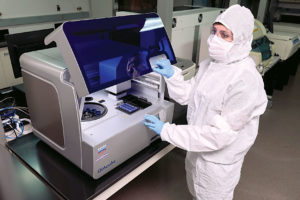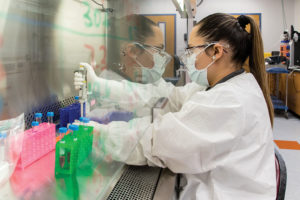Keeping the world’s medicines safe from unwanted viruses is no small task for the biomanufacturing industry. But so far, the industry’s track record has been fairly good. “Fortunately, contamination is a rare event in our industry, but vigilance in terms of biosafety testing, including viral safety testing and viral clearance studies, are key elements of that impressive safety profile,” reflects Andrew Bulpin, PhD, head of process solutions at MilliporeSigma.
Viral vector and gene therapy products face unique challenges in viral safety testing because in most cases, the therapy itself is based on a virus, or viral material. According to Bulpin, “The challenge arises in terms of broad virus detection testing that will pick up not only potentially contaminating viruses, but also the virus that you are using as your therapeutic vector. How do you differentiate between the ‘good’ virus (which you want to be there) and adventitious viruses (which you do not want to be there)?”
Bulpin says that classical testing methods are culture based: “Competition between the virus being used as the vector, and the ability to detect adventitious virus (to see a true infection/contamination), means that neutralizing antiserum is required for the viral vector. This isn’t something developers always have on hand.”
Bulpin is aware that his observation is relevant to the current coronavirus situation. “Vaccines based on SARS-CoV-2 are being rapidly developed, and neutralizing antisera are unlikely to be available,” he continues. “In these circumstances, regulators expect to see molecular methods being employed instead.”
In general, viral vector testing encompasses identity, purity, potency, and safety testing. Bulpin notes that identity testing checks whether the right gene is being manufactured and whether the right protein is being expressed. Purity testing characterizes whatever manufacturing and process byproducts might be present. Potency testing determines the product’s quantity and level of activity. Safety testing ensures the product is free of unwanted adventitious agents.
Testing varies depending on the type of therapy (for example, chimeric antigen receptor T-cell or in vivo gene therapy), type of therapeutic vector, and methodology of production (that is, transient transfection, stable transfection, or addition of helper virus). For example, the testing package for a lentivirus-based therapy is very different from that for an adeno-associated virus (AAV)-based therapy.
Bulpin explains, “AAV therapies are another great example of the variety of testing involved as the different serotypes of AAV also require slightly different testing. For example, AAV5 will need different testing compared to AAV8 to determine if the correct capsid proteins are present. Of course, absence of replication-competent virus for the virus type used in the therapy is crucial.
“The techniques used to assure absence of replication competence are different from the broad-spectrum sweep that you would perform to be sure that no other viral contaminants are present. More directed systems need to be used based on the virus of interest, for example, using cell lines permissive for the growth of that virus.”
MilliporeSigma offers biosafety testing packages that are not limited to just viral safety. Bulpin indicates, “We look for a comprehensive range of contaminants of concern. Testing is available for the broadest range of vector types commonly utilized in the gene therapy industry, from adenovirus, lentivirus, AAV, and also some of the lesser-used vectors such as vaccinia.
“Although there’s generally no terminal sterilization step, there are opportunities for some kind of downstream purification on a case-by-case basis. There can be a misconception that you do not need to perform a viral clearance study for gene therapy products, but in fact regulators expect to see this study performed on those virus types that can be purified, for example, enveloped viruses.”
One size does not fit all
Steven Miklasz, advanced therapy and key accounts development director, biologics testing solutions, Charles River Laboratories, agrees that different products require different safety testing plans. “Regulatory agencies need to define the tests and testing points that make most sense for each product,” he adds. “Also, each product could have a different delivery (for example, intravenous/systemic vs. direct placement into the eye), and this changes the safety requirements slightly. Therefore, these unique challenges do not abide by a ‘one size fits all’ model.”
There are several guidelines in place for companies to consult. Miklasz advises, “Gene therapies can follow the Chemistry, Manufacturing, and Control Information for Human Gene Therapy Investigational New Drug Applications, authored January 2020. Cell therapies can follow the Content and Review of Chemistry, Manufacturing, and Control Information for Human Somatic Cell Therapy Investigational New Drug Applications, authored April 2008. There is also relevant guidance found in Characterization and Qualification of Cell Substrates and Other Biological Materials Used in the Production of Viral Vaccines for Infectious Disease Indications, authored February 2010. Other documents include Points to Consider in the Characterization of Cell Lines Used to Produce Biologicals and Testing of Retroviral Vector-Based Human Gene Therapy Products for Replication Competent Retrovirus during Product Manufacture and Patient Follow-up. In short, there is plenty of guidance available outside your typical FDA Type C meetings.”
Lentivirus is a perfect example of a required replication-competent test. It can be performed on manufactured lentivirus vectors as well as on ex vivo lentivirus modified cell therapies. Miklasz points out, “In principle, the assay needs to detect a very small amount of potential contaminating viral particles in a large pool, so an amplification step is required. High-titer virus can be obtained from small amounts of contamination by passaging the test particle onto an appropriate indicator cell line like the C8166 T-cell line.
“The use of p24 ELISA and PERT testing allow the amplified products to be measured against positive, negative, and spiked controls. The P24 antigen and the retroviral reverse transcriptase are two potential tests for replication-competent lentivirus formation. Other quantitative tests (such as quantitative polymerase chain reaction tests) may also be appropriate and can be added as needed.”
The company offers a comprehensive repertoire of services aimed to achieve the needs of gene, cell, and oncolytic virus therapies. Miklasz reports, “We are always refining our testing, and we offer custom assay development as needed to provide content to achieve specific product release requirements. Our clients require GMP cell/viral banks, cell/viral bank characterization and release testing, viral inactivation/clearance, genome sequencing, residual/contaminant testing, and potency testing. Our testing satisfies the majority of requested testing.”
Patient-centric approach
In 2015, PPD Laboratories tightened its focus on rare disease and pediatric medicine. “This helped prepare us for the patient-centric needs of gene therapy,” says Patrick Bennett, vice president of strategy at PPD Laboratories. “This also resulted in the creation of dedicated concierge services focused on patients, sites, and lab services. Our lab concierge services provide an ultra-attentive method for tracking kits, logistics, analysis, and reporting at an individual patient level.”

The company is also addressing viral safety testing. Bennett notes, “Thorough characterization of the drug product and patient samples are critical to ensuring patient safety. We have been increasing our analytic technique offerings to include the addition of analytical ultracentrifugation, quantitative PCR, digital droplet PCR, Sanger sequencing, and replication competency testing to support the characterization needs of gene and select cell therapies.”
However, the current viral safety testing climate continues to have its challenges. Panteli Theocharous, PhD, PPD’s global vice president, cell and gene therapy strategy lead, reports, “For any gene therapy with persistent biological activity, the potential for delayed adverse events is currently considered high. Regulators now recommend that long-term follow-up observational studies be conducted to mitigate any potential extended risks to subjects receiving these viral vectors. Another challenge is the establishment of critical reagents for long-term use. Yet another is the lack of definition from regulatory agencies on which assays are required and how certain biomarker data are used.”
Limited history challenges
Susan D’Costa, PhD, senior director, technical program design, viral vector services, Thermo Fisher Scientific, comments about other challenges that remain in the field: “The gene therapy field is growing exponentially with limited knowledge of critical quality attributes, specifically as they relate to product and process impurities. With multiple platforms to produce vectors, the data that is currently available cannot be trended toward a single unifying theme.

“Given the accelerated timelines and the speed to market, there is limited development and manufacturing history for these products. Commercial processes are often not locked in until after late-stage clinical manufacturing. Finally, the analytical tools available are limited by chemistry, sensitivity, precision, and accuracy, making it difficult to set realistic release specifications for the products.”
According to D’Costa, Thermo Fisher has made several strategic investments to support the need for greater innovation in cell and gene therapy, including its acquisition of Brammer Bio last year and a new commercial manufacturing site in Plainville, MA, that will more than double the company’s commercial viral vector capacity. She points out, “Thermo Fisher’s services aim to ensure quality, yield, and efficiency of processes, providing support from the drug development stage through to clinical trials and commercial production.”
Averting clandestine contamination
Although viral safety testing has been largely successful, there remains a need for rapid, broad-level detection of known and unknown viruses. This need is being addressed by GenScript ProBio, a company that supplies molecular and functional reagents to support viral testing.
Kenneth Warrington, PhD, head, strategy and innovation, and senior director, business development, GenScript ProBio, reflects, “There is a growing trend to employ next-generation sequencing (NGS) methods for a more global assessment for biosafety release testing. While most viral safety testing assesses very specific families of viruses, there could be contamination from other known or unknown viruses not included in these testing panels.
“An advantage of NGS is that detection does not require a prior knowledge of potential adventitious viruses. With NGS, you can identify any nucleic acid in the product and compare that to databases of viral sequences. However, this doesn’t determine if there is live virus, if there are virus particles, or even if there are parts of a host cell. NGS is also still relatively new from a regulatory standpoint.”
For the future
Miklasz provided a perspective on what to expect next in the field of viral safety testing: “I think it’s safe to say that implementation of new technologies is always needed. I think the major challenge is that each product has specific quality attributes that need to be comparable for each lot of material released.
“These quality attributes will differ based on the disease indication and the modality of the treatment. They represent the ‘art’ in testing, and there will always be some level of evolution around how we can obtain safer biologics faster. Because we are creatively leveraging the attributes of novel viral vectors to extend our repertoire of therapeutic modalities, I would say that we still have a lot of good surprises ahead of us!”


Comments are closed.